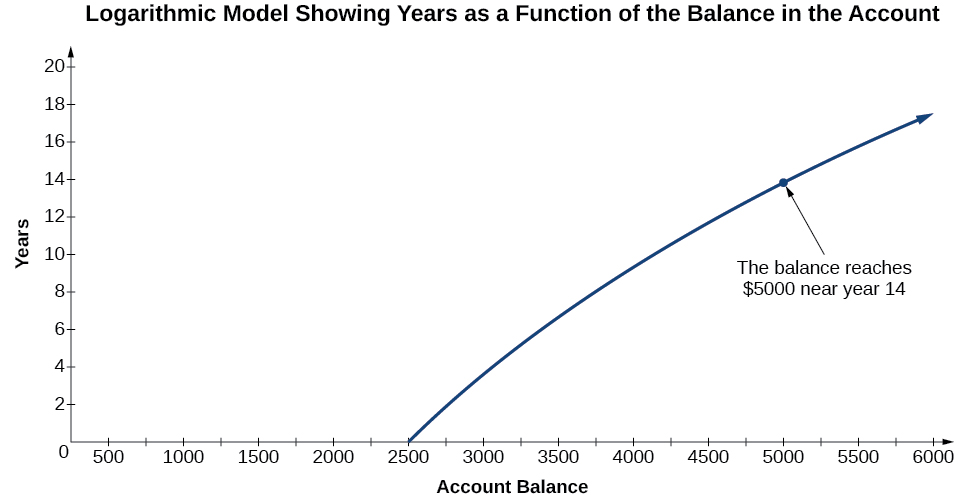
In this section, you will:
In Graphs of Exponential Functions, we saw how creating a graphical representation of an exponential model gives us another layer of insight for predicting future events. How do logarithmic graphs give us insight into situations? Because every logarithmic function is the inverse function of an exponential function, we can think of every output on a logarithmic graph as the input for the corresponding inverse exponential equation. In other words, logarithms give the cause for an effect.
To illustrate, suppose we invest
in an account that offers an annual interest rate of
compounded continuously. We already know that the balance in our account for any year
can be found with the equation
But what if we wanted to know the year for any balance? We would need to create a corresponding new function by interchanging the input and the output; thus we would need to create a logarithmic model for this situation. By graphing the model, we can see the output (year) for any input (account balance). For instance, what if we wanted to know how many years it would take for our initial investment to double? [link] shows this point on the logarithmic graph.

In this section we will discuss the values for which a logarithmic function is defined, and then turn our attention to graphing the family of logarithmic functions.
Before working with graphs, we will take a look at the domain (the set of input values) for which the logarithmic function is defined.
Recall that the exponential function is defined as
for any real number
and constant
where
is
is
In the last section we learned that the logarithmic function
is the inverse of the exponential function
So, as inverse functions:
is the range of
is the domain of
Transformations of the parent function
behave similarly to those of other functions. Just as with other parent functions, we can apply the four types of transformations—shifts, stretches, compressions, and reflections—to the parent function without loss of shape.
In Graphs of Exponential Functions we saw that certain transformations can change the range of
Similarly, applying transformations to the parent function
can change the domain. When finding the domain of a logarithmic function, therefore, it is important to remember that the domain consists only of positive real numbers. That is, the argument of the logarithmic function must be greater than zero.
For example, consider
This function is defined for any values of
such that the argument, in this case
is greater than zero. To find the domain, we set up an inequality and solve for
In interval notation, the domain of
is
Given a logarithmic function, identify the domain.
What is the domain of
The logarithmic function is defined only when the input is positive, so this function is defined when
Solving this inequality,
The domain of
is
What is the domain of
What is the domain of
The logarithmic function is defined only when the input is positive, so this function is defined when
Solving this inequality,
The domain of
is
What is the domain of
Now that we have a feel for the set of values for which a logarithmic function is defined, we move on to graphing logarithmic functions. The family of logarithmic functions includes the parent function
along with all its transformations: shifts, stretches, compressions, and reflections.
We begin with the parent function
Because every logarithmic function of this form is the inverse of an exponential function with the form
their graphs will be reflections of each other across the line
To illustrate this, we can observe the relationship between the input and output values of
and its equivalent
in [link].
|
</math></strong> |
| |
</math></strong> |
| |
</math></strong> |
Using the inputs and outputs from [link], we can build another table to observe the relationship between points on the graphs of the inverse functions
and
See [link].
|
</math></strong> |
| |
</math></strong> |
As we’d expect, the x- and y-coordinates are reversed for the inverse functions. [link] shows the graph of
and
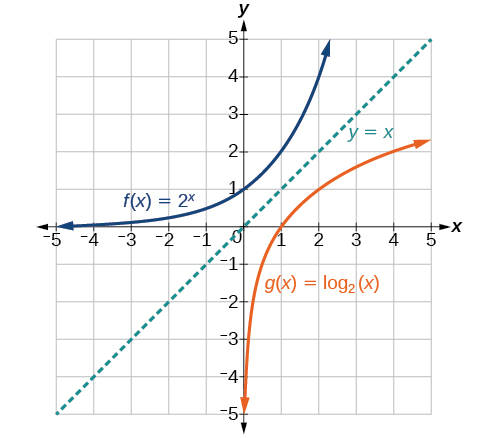
Observe the following from the graph:
has a y-intercept at
and
has an x- intercept at
is the same as the range of
is the same as the domain of
For any real number
and constant
we can see the following characteristics in the graph of
and key point
See [link].
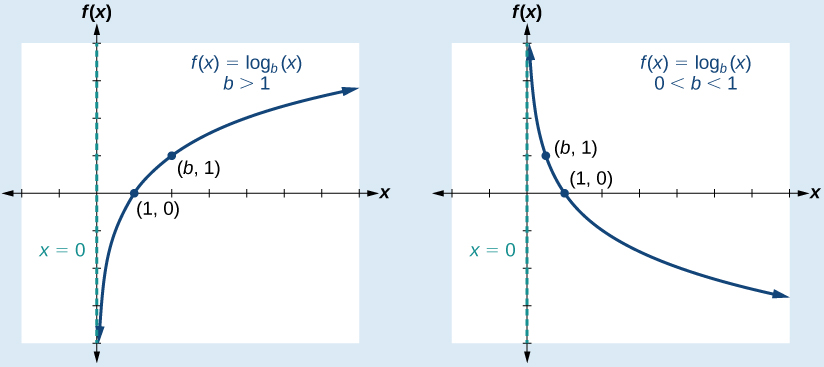
[link] shows how changing the base
in
can affect the graphs. Observe that the graphs compress vertically as the value of the base increases. (Note: recall that the function
has base
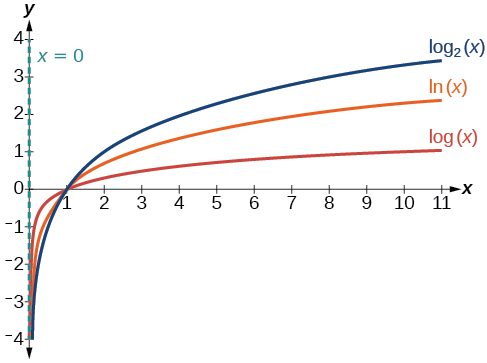
**Given a logarithmic function with the form
graph the function.**
the range,
and the vertical asymptote,
Graph
State the domain, range, and asymptote.
Before graphing, identify the behavior and key points for the graph.
is greater than one, we know the function is increasing. The left tail of the graph will approach the vertical asymptote
and the right tail will increase slowly without bound.
is on the graph.
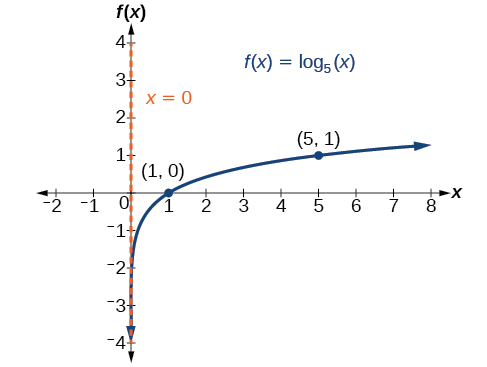
The domain is
the range is
and the vertical asymptote is
Graph
State the domain, range, and asymptote.
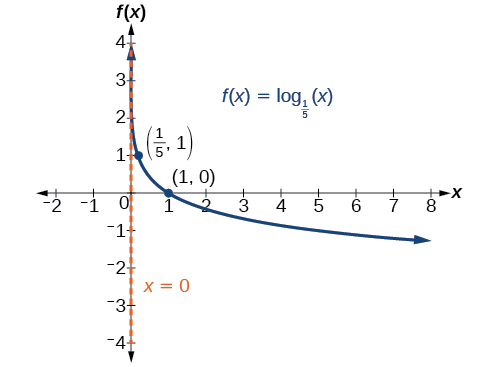 The domain is
The domain is
the range is
and the vertical asymptote is
As we mentioned in the beginning of the section, transformations of logarithmic graphs behave similarly to those of other parent functions. We can shift, stretch, compress, and reflect the parent function
without loss of shape.
When a constant
is added to the input of the parent function
the result is a horizontal shift
units in the opposite direction of the sign on
To visualize horizontal shifts, we can observe the general graph of the parent function
and for
alongside the shift left,
and the shift right,
See [link].
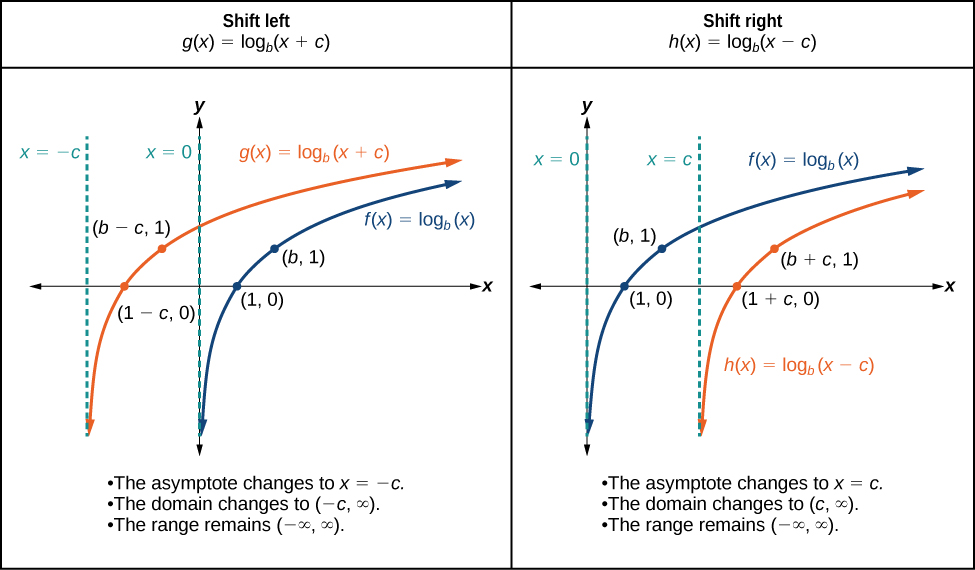
For any constant
the function
left
units if
right
units if
**Given a logarithmic function with the form
graph the translation.**
shift the graph of
left
units.
shift the graph of
right
units.
from the
coordinate.
the range is
and the vertical asymptote is
Sketch the horizontal shift
alongside its parent function. Include the key points and asymptotes on the graph. State the domain, range, and asymptote.
Since the function is
we notice
Thus
so
This means we will shift the function
right 2 units.
The vertical asymptote is
or
Consider the three key points from the parent function,
and
The new coordinates are found by adding 2 to the
coordinates.
Label the points
and
The domain is
the range is
and the vertical asymptote is
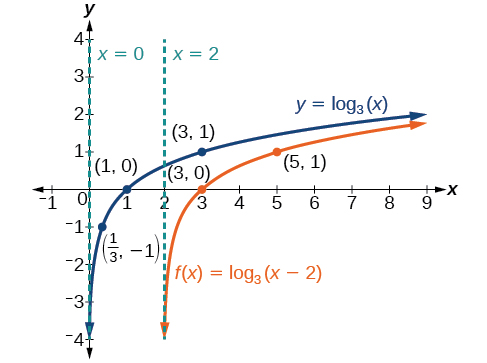
Sketch a graph of
alongside its parent function. Include the key points and asymptotes on the graph. State the domain, range, and asymptote.
 The domain is
The domain is
the range
and the asymptote
When a constant
is added to the parent function
the result is a vertical shift
units in the direction of the sign on
To visualize vertical shifts, we can observe the general graph of the parent function
alongside the shift up,
and the shift down,
See [link].
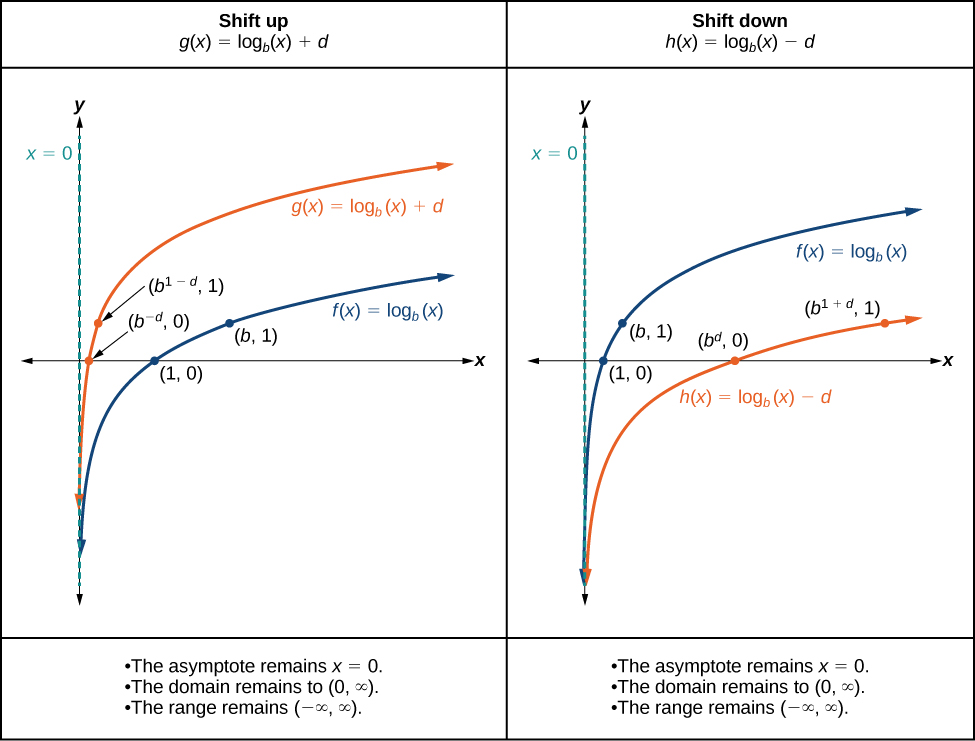
For any constant
the function
up
units if
down
units if
**Given a logarithmic function with the form
graph the translation.**
shift the graph of
up
units.
shift the graph of
down
units.
to the
coordinate.
the range is
and the vertical asymptote is
Sketch a graph of
alongside its parent function. Include the key points and asymptote on the graph. State the domain, range, and asymptote.
Since the function is
we will notice
Thus
This means we will shift the function
down 2 units.
The vertical asymptote is
Consider the three key points from the parent function,
and
The new coordinates are found by subtracting 2 from the y coordinates.
Label the points
and
The domain is
the range is
and the vertical asymptote is
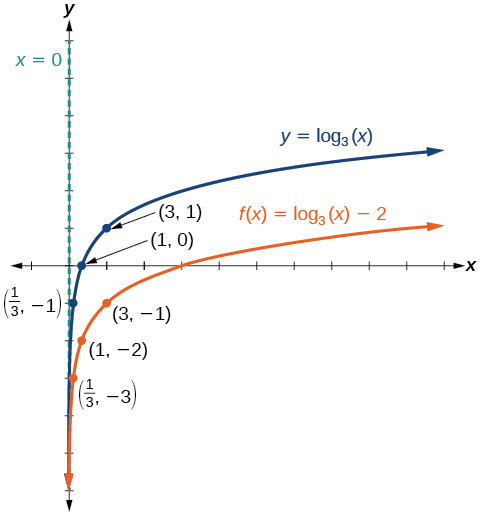
The domain is
the range is
and the vertical asymptote is
Sketch a graph of
alongside its parent function. Include the key points and asymptote on the graph. State the domain, range, and asymptote.
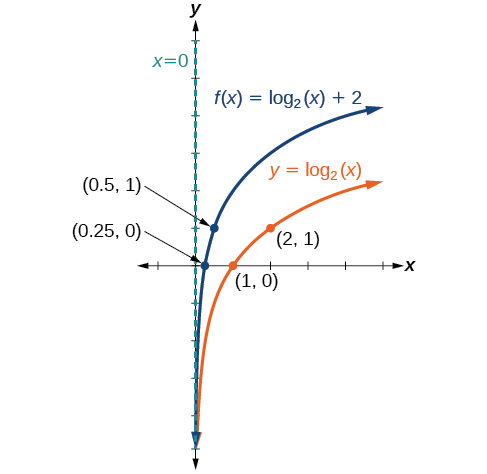 The domain is
The domain is
the range is
and the vertical asymptote is
When the parent function
is multiplied by a constant
the result is a vertical stretch or compression of the original graph. To visualize stretches and compressions, we set
and observe the general graph of the parent function
alongside the vertical stretch,
and the vertical compression,
See [link].
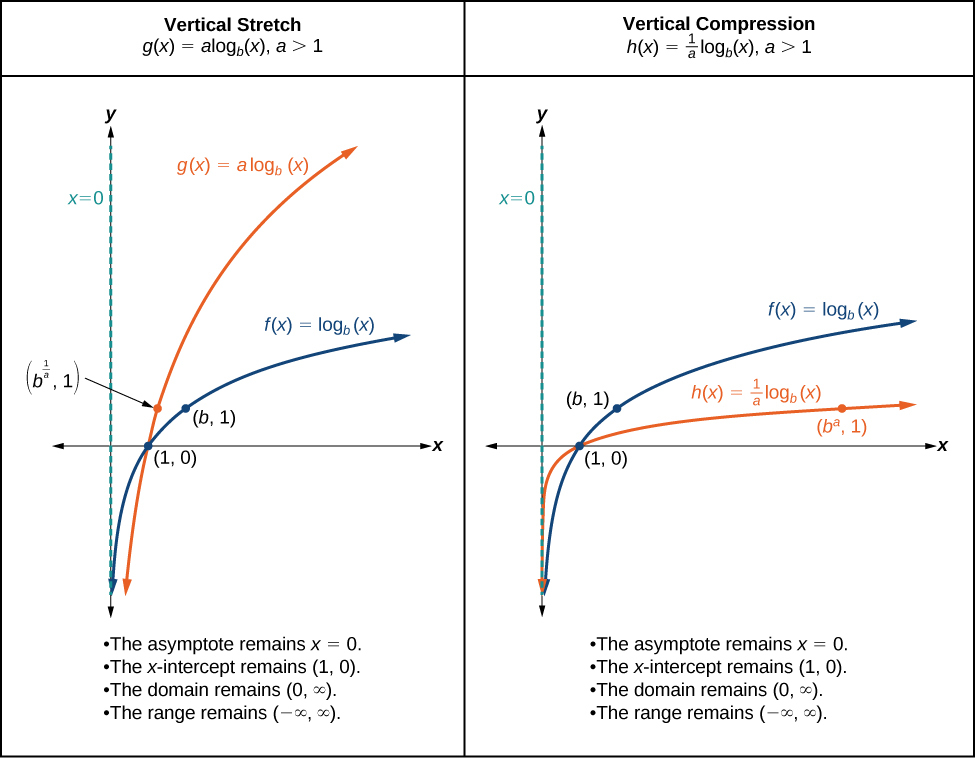
For any constant
the function
vertically by a factor of
if
vertically by a factor of
if
**Given a logarithmic function with the form
graph the translation.**
the graph of
is stretched by a factor of
units.
the graph of
is compressed by a factor of
units.
coordinates by
the range is
and the vertical asymptote is
Sketch a graph of
alongside its parent function. Include the key points and asymptote on the graph. State the domain, range, and asymptote.
Since the function is
we will notice
This means we will stretch the function
by a factor of 2.
The vertical asymptote is
Consider the three key points from the parent function,
and
The new coordinates are found by multiplying the
coordinates by 2.
Label the points
and
The domain is
the range is
and the vertical asymptote is
See [link].
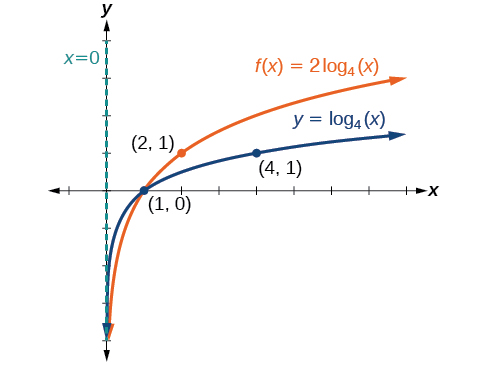
The domain is
the range is
and the vertical asymptote is
Sketch a graph of
alongside its parent function. Include the key points and asymptote on the graph. State the domain, range, and asymptote.
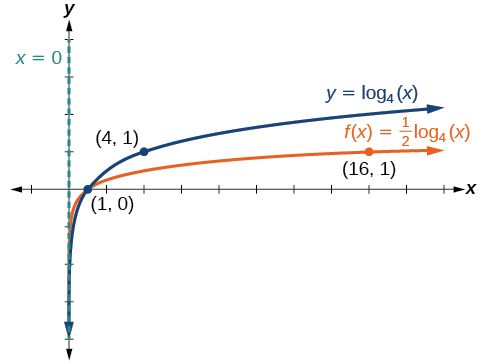 The domain is
The domain is
the range is
and the vertical asymptote is
Sketch a graph of
State the domain, range, and asymptote.
Remember: what happens inside parentheses happens first. First, we move the graph left 2 units, then stretch the function vertically by a factor of 5, as in [link]. The vertical asymptote will be shifted to
The x-intercept will be
The domain will be
Two points will help give the shape of the graph:
and
We chose
as the x-coordinate of one point to graph because when
the base of the common logarithm.

The domain is
the range is
and the vertical asymptote is
Sketch a graph of the function
State the domain, range, and asymptote.
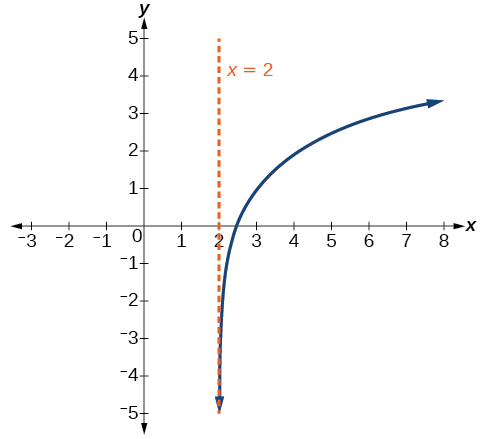 The domain is
The domain is
the range is
and the vertical asymptote is
When the parent function
is multiplied by
the result is a reflection about the x-axis. When the input is multiplied by
the result is a reflection about the y-axis. To visualize reflections, we restrict
and observe the general graph of the parent function
alongside the reflection about the x-axis,
and the reflection about the y-axis,
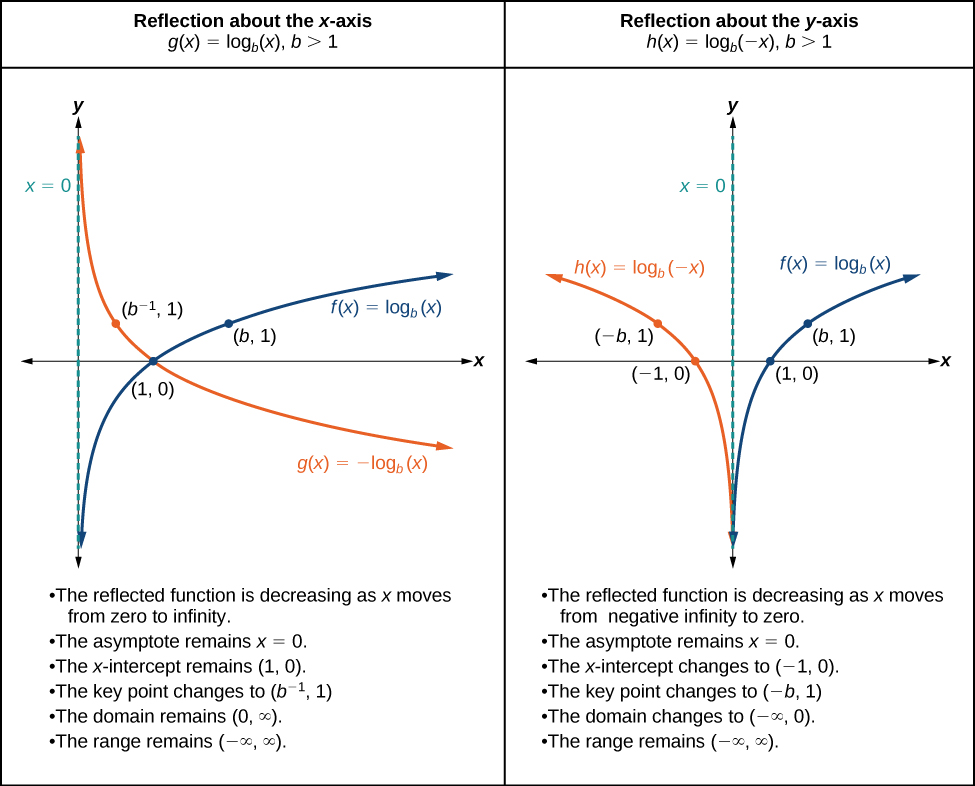
The function
about the x-axis.
range,
and vertical asymptote,
which are unchanged from the parent function.
The function
about the y-axis.
and vertical asymptote,
which are unchanged from the parent function.
**Given a logarithmic function with the parent function
graph a translation.**
|
|
|
|
|
|
|
|
|
|
Sketch a graph of
alongside its parent function. Include the key points and asymptote on the graph. State the domain, range, and asymptote.
Before graphing
identify the behavior and key points for the graph.
is greater than one, we know that the parent function is increasing. Since the input value is multiplied by
is a reflection of the parent graph about the y-axis. Thus,
will be decreasing as
moves from negative infinity to zero, and the right tail of the graph will approach the vertical asymptote
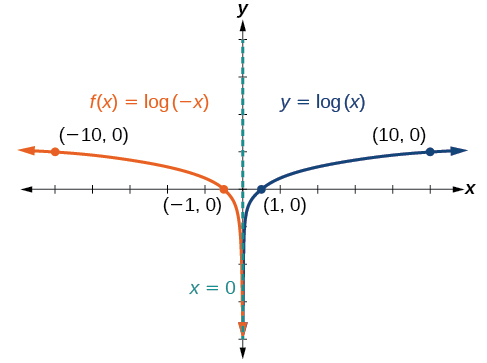
The domain is
the range is
and the vertical asymptote is
Graph
State the domain, range, and asymptote.
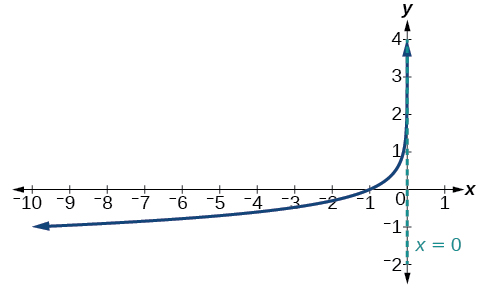 The domain is
The domain is
the range is
and the vertical asymptote is
Given a logarithmic equation, use a graphing calculator to approximate solutions.
we compute the point of intersection. Press [2ND] then [CALC]. Select “intersect” and press [ENTER] three times. The point of intersection gives the value of
for the point(s) of intersection.
Solve
graphically. Round to the nearest thousandth.
Press [Y=] and enter
next to Y1=. Then enter
next to Y2=. For a window, use the values 0 to 5 for
and –10 to 10 for
Press [GRAPH]. The graphs should intersect somewhere a little to right of
For a better approximation, press [2ND] then [CALC]. Select [5: intersect] and press [ENTER] three times. The x-coordinate of the point of intersection is displayed as 1.3385297. (Your answer may be different if you use a different window or use a different value for Guess?) So, to the nearest thousandth,
Solve
graphically. Round to the nearest thousandth.
Now that we have worked with each type of translation for the logarithmic function, we can summarize each in [link] to arrive at the general equation for translating exponential functions.
| Translations of the Parent Function | |
|---|---|
| Translation | Form |
Shift
|
|
Stretch and Compress
|
|
| Reflect about the x-axis | |
| Reflect about the y-axis | |
| General equation for all translations | |
All translations of the parent logarithmic function,
have the form
where the parent function,
is
units.
units.
if
if
For
the graph of the parent function is reflected about the y-axis.
What is the vertical asymptote of
The vertical asymptote is at
The coefficient, the base, and the upward translation do not affect the asymptote. The shift of the curve 4 units to the left shifts the vertical asymptote to
What is the vertical asymptote of
Find a possible equation for the common logarithmic function graphed in [link].
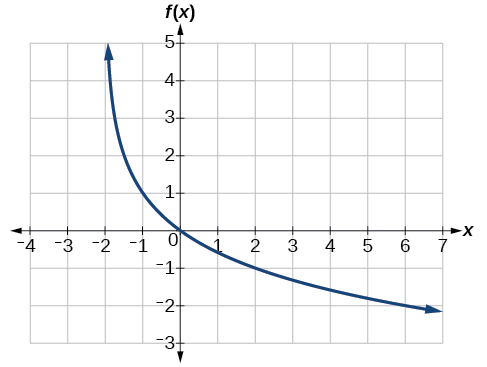
This graph has a vertical asymptote at
and has been vertically reflected. We do not know yet the vertical shift or the vertical stretch. We know so far that the equation will have form:
It appears the graph passes through the points
and
Substituting
Next, substituting in
,
This gives us the equation
Give the equation of the natural logarithm graphed in [link].

Is it possible to tell the domain and range and describe the end behavior of a function just by looking at the graph?
Yes, if we know the function is a general logarithmic function. For example, look at the graph in [link]. The graph approaches
</math>(or thereabouts) more and more closely, so
</math>is, or is very close to, the vertical asymptote. It approaches from the right, so the domain is all points to the right,
</math>The range, as with all general logarithmic functions, is all real numbers. And we can see the end behavior because the graph goes down as it goes left and up as it goes right. The end behavior is that as
</math>and as
</math></em>
Access these online resources for additional instruction and practice with graphing logarithms.
| General Form for the Translation of the Parent Logarithmic Function |
has an x-intercept at
domain
range
vertical asymptote
and
the function is increasing.
the function is decreasing.
See [link].
shifts the parent function
horizontally
units if
units if
See [link].
shifts the parent function
vertically
units if
units if
See [link].
the equation
vertically by a factor of
if
vertically by a factor of
if
is multiplied by
the result is a reflection about the x-axis. When the input is multiplied by
the result is a reflection about the y-axis.
represents a reflection of the parent function about the x-axis.
represents a reflection of the parent function about the y-axis.
See [link].
See [link].
we can identify the vertical asymptote
for the transformation. See [link].
we can write the equation of a logarithmic function given its graph. See [link].
The inverse of every logarithmic function is an exponential function and vice-versa. What does this tell us about the relationship between the coordinates of the points on the graphs of each?
Since the functions are inverses, their graphs are mirror images about the line
So for every point
on the graph of a logarithmic function, there is a corresponding point
on the graph of its inverse exponential function.
What type(s) of translation(s), if any, affect the range of a logarithmic function?
What type(s) of translation(s), if any, affect the domain of a logarithmic function?
Shifting the function right or left and reflecting the function about the y-axis will affect its domain.
Consider the general logarithmic function
Why can’t
be zero?
Does the graph of a general logarithmic function have a horizontal asymptote? Explain.
No. A horizontal asymptote would suggest a limit on the range, and the range of any logarithmic function in general form is all real numbers.
For the following exercises, state the domain and range of the function.
Domain:
Range:
Domain:
Range:
For the following exercises, state the domain and the vertical asymptote of the function.
Domain:
Vertical asymptote:
Domain:
Vertical asymptote:
Domain:
Vertical asymptote:
For the following exercises, state the domain, vertical asymptote, and end behavior of the function.
Domain:
; * * *
Vertical asymptote:
; End behavior: as
and as
Domain:
; Vertical asymptote:
; * * *
End behavior: as
,
and as
,
For the following exercises, state the domain, range, and x- and y-intercepts, if they exist. If they do not exist, write DNE.
Domain:
Range:
Vertical asymptote:
x-intercept:
y-intercept: DNE
Domain:
Range:
Vertical asymptote:
x-intercept:
y-intercept: DNE
Domain:
Range:
Vertical asymptote:
x-intercept:
y-intercept: DNE
For the following exercises, match each function in [link] with the letter corresponding to its graph.
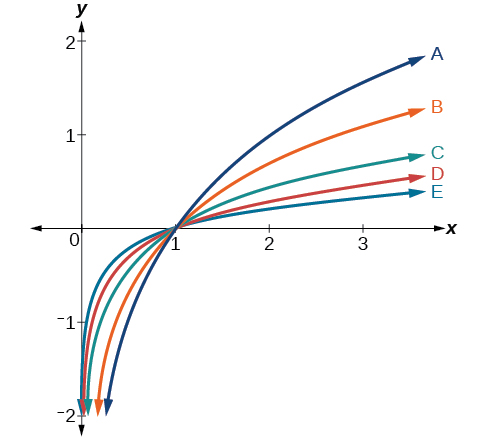
B
C
For the following exercises, match each function in [link] with the letter corresponding to its graph.
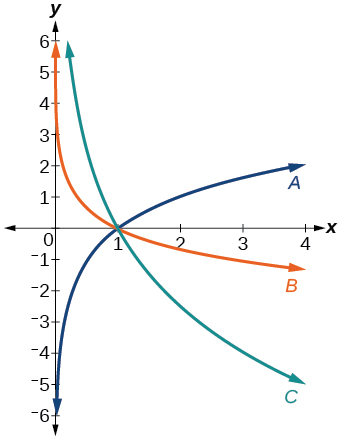
B
C
For the following exercises, sketch the graphs of each pair of functions on the same axis.
and
and
and
and
For the following exercises, match each function in [link] with the letter corresponding to its graph.

C
For the following exercises, sketch the graph of the indicated function.
For the following exercises, write a logarithmic equation corresponding to the graph shown.
Use
as the parent function.
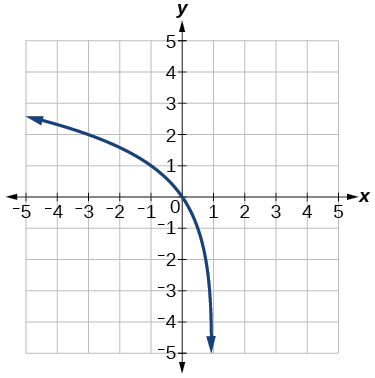
Use
as the parent function.
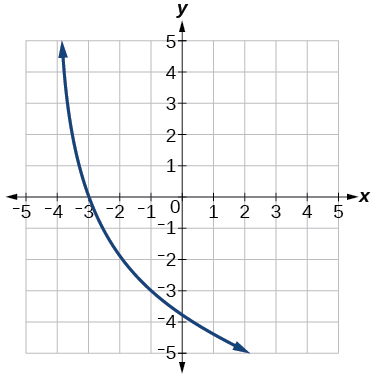
Use
as the parent function.
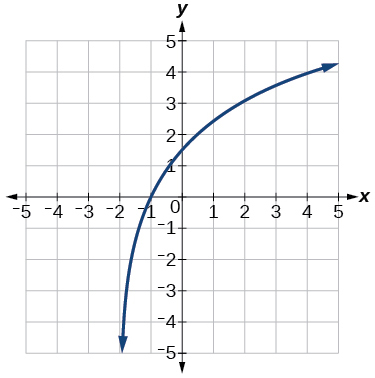
Use
as the parent function.
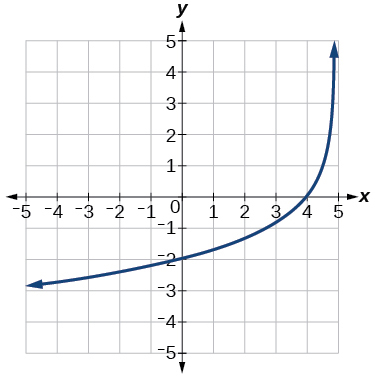
For the following exercises, use a graphing calculator to find approximate solutions to each equation.
Let
be any positive real number such that
What must
be equal to? Verify the result.
Explore and discuss the graphs of
and
Make a conjecture based on the result.
The graphs of
and
appear to be the same; Conjecture: for any positive base
Prove the conjecture made in the previous exercise.
What is the domain of the function
Discuss the result.
Recall that the argument of a logarithmic function must be positive, so we determine where
. From the graph of the function
note that the graph lies above the x-axis on the interval
and again to the right of the vertical asymptote, that is
Therefore, the domain is

Use properties of exponents to find the x-intercepts of the function
algebraically. Show the steps for solving, and then verify the result by graphing the function.

You can also download for free at http://cnx.org/contents/fd53eae1-fa23-47c7-bb1b-972349835c3c@8.1
Attribution: